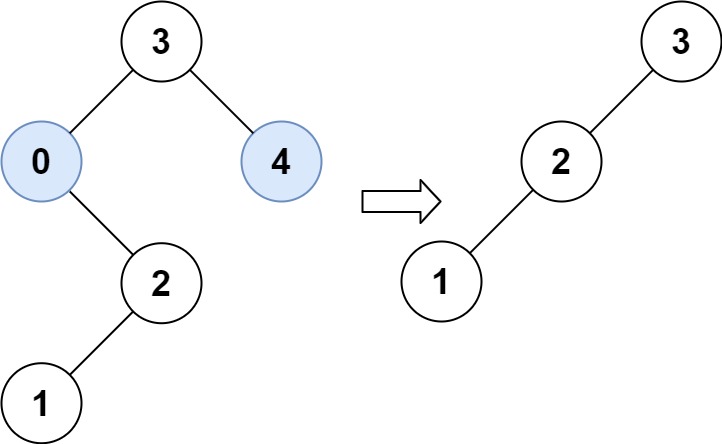Given the root of a binary search tree and the lowest and highest boundaries as low and high, trim the tree so that all its elements lies in [low, high]. Trimming the tree should not change the relative structure of the elements that will remain in the tree (i.e., any node's descendant should remain a descendant). It can be proven that there is a unique answer.
Return the root of the trimmed binary search tree. Note that the root may change depending on the given bounds.
Example 1:

Input: root = [1,0,2], low = 1, high = 2 Output: [1,null,2]
Example 2:

Input: root = [3,0,4,null,2,null,null,1], low = 1, high = 3 Output: [3,2,null,1]
Constraints:
- The number of nodes in the tree is in the range
[1, 104]. 0 <= Node.val <= 104- The value of each node in the tree is unique.
rootis guaranteed to be a valid binary search tree.0 <= low <= high <= 104
A:
递归啊,没别的方法
/*** Definition for a binary tree node.* struct TreeNode {* int val;* TreeNode *left;* TreeNode *right;* TreeNode() : val(0), left(nullptr), right(nullptr) {}* TreeNode(int x) : val(x), left(nullptr), right(nullptr) {}* TreeNode(int x, TreeNode *left, TreeNode *right) : val(x), left(left), right(right) {}* };*/class Solution {public:TreeNode* trimBST(TreeNode* root, int low, int high) {return helper(root, low, high);}private:TreeNode* helper(TreeNode* root, int low, int high ){if(!root)return root;if(root->val < low){return helper(root->right, low, high);}else if(root->val > high){return helper(root->left, low, high);}else{ // root->val is in range, we then need delete both child-treeroot->left = helper(root->left, low, high);root->right = helper(root->right, low, high);return root;}}};上面的代码,很快就过了。但是有 memory leak。 真正的工作代码中,应该加上delete()/*** Definition for a binary tree node.* struct TreeNode {* int val;* TreeNode *left;* TreeNode *right;* TreeNode() : val(0), left(nullptr), right(nullptr) {}* TreeNode(int x) : val(x), left(nullptr), right(nullptr) {}* TreeNode(int x, TreeNode *left, TreeNode *right) : val(x), left(left), right(right) {}* };*/class Solution {public:TreeNode* trimBST(TreeNode* root, int low, int high) {return helper(root, low, high);}private:TreeNode* helper(TreeNode* root, int low, int high ){if(!root)return root;if(root->val < low){auto res = helper(root->right, low, high);deleteTree(root->left);delete(root);return res;}else if(root->val > high){auto res = helper(root->left, low, high);deleteTree(root->right);delete(root);return res;}else{ // root->val is in range, we then need delete both child-treeroot->left = helper(root->left, low, high);root->right = helper(root->right, low, high);return root;}}void deleteTree(TreeNode* root){if(!root)return;deleteTree(root->left);deleteTree(root->right);delete(root);}};但是上面的代码,在LC中,有error,显示: 判题器可能还在用root指针。从error message 来看,leetcode会帮忙删除这些内存。因此面试的时候,可以说。但是不需要写了
No comments:
Post a Comment